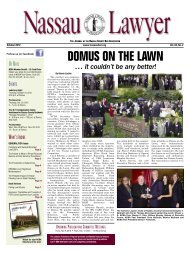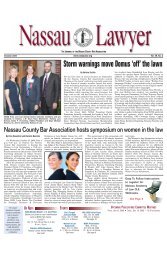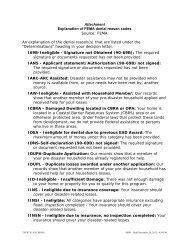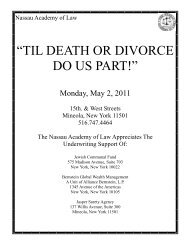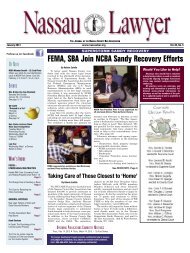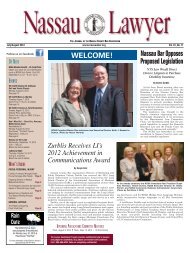FRAUDULENT CONVEYANCES Nassau Academy of Law CLE Live ...
FRAUDULENT CONVEYANCES Nassau Academy of Law CLE Live ...
FRAUDULENT CONVEYANCES Nassau Academy of Law CLE Live ...
You also want an ePaper? Increase the reach of your titles
YUMPU automatically turns print PDFs into web optimized ePapers that Google loves.
Page 5257 A.D.2d 526, 684 N.Y.S.2d 244, 1999 N.Y. Slip Op. 00749(Cite as: 257 A.D.2d 526, 684 N.Y.S.2d 244)fact and an intra-family transaction places a heavierburden on defendant to demonstrate fairness (Liggiov. Liggio, 53 A.D.2d 543, 549, 385 N.Y.S.2d 33).Similarly, we find that plaintiff sufficiently assertedclaims under DCL §§ 275 and 276. DCL § 275 providesthat:Every conveyance made and every obligation incurredwithout fair consideration when the personmaking the conveyance or entering into the obligationintends or believes that he will incur debts beyondhis ability to pay as they mature, is fraudulentas to both present and future creditorsA claim under this provision requires, in addition tothe conveyance and unfair consideration elementsestablished supra, an element <strong>of</strong> intent or belief thatinsolvency will result (see, Shelly v. Doe, 249 A.D.2d756, 671 N.Y.S.2d 803). That requirement is satisfiedhere, at the least as to Friedman, by his aforementionedarbitration testimony that it was his intent thatissuance <strong>of</strong> his shares to his spouse would insulatehim from anticipated legal liability.[6][7][8] DCL § 276 provides that:Every conveyance made and every obligation incurredwith actual intent, as *529 distinguishedfrom intent presumed in law, to hinder, delay, ordefraud either present or future creditors, is fraudulentas to both present and future creditors.DCL § 276, unlike sections 273 and 275, addressesactual fraud, as opposed to constructive fraud, anddoes not require pro<strong>of</strong> <strong>of</strong> unfair consideration or insolvency(see, United States v. Carlin, supra). Due tothe difficulty <strong>of</strong> proving actual intent to hinder, delay,or defraud creditors, the pleader is allowed to rely on“badges <strong>of</strong> fraud” to support his case, i.e., circumstancesso commonly associated with fraudulenttransfers “that their presence gives rise to an inference<strong>of</strong> intent”, (Pen Pak Corp. v. LaSalle NationalBank <strong>of</strong> Chicago, 240 A.D.2d 384, 386, 658N.Y.S.2d 407, quoting **248MFS/Sun Life Trust-High Yield Series v. Van Dusen Airport Servs. Co.,910 F.Supp. 913, 935; Shelly v. Doe, 249 A.D.2d756, 671 N.Y.S.2d 803 supra). Among such circumstancesare: a close relationship between the partiesto the alleged fraudulent transaction; a questionabletransfer not in the usual course <strong>of</strong> business; inadequacy<strong>of</strong> the consideration; the transferor's knowledge<strong>of</strong> the creditor's claim and the inability to pay it;and retention <strong>of</strong> control <strong>of</strong> the property by the transferorafter the conveyance.Here, the second amended complaint clearly allegessufficient badges <strong>of</strong> fraud to support a DCL § 276cause <strong>of</strong> action: that Wise and Friedman caused acompany they organized and controlled, Enseco, toissue their respective 25 HARES OF ITS STOCK TOTHEIR SPOUSES FOR A CONSIDERATION OFQUESTIONABLE FAIRNESS; THAT FRIEDMANCAUSED HIS STOCK TO BE TRANSFERRED TOHIS SPOUSE WITH THE EXPRESS INTENT TOREMOVE THOSE ASSETS FROM THE REACHOF ANTICIPATED JUDGMENT CREDITORS;AND THAT THESE TRANSFERS RENDEREDWISE AND FRIEDMAN JUDGMENT PROOF.It should be noted that the third amended complaintand its accompanying submissions are unquestionablysufficient to establish the existence <strong>of</strong> any and all<strong>of</strong> the aforementioned DCL-based claims. In additionto establishing the elements noted above, it refers toan affidavit by defendant Wise wherein he admitsthat both his and Friedman's stock transfers tospouses were intended to defeat anticipated creditors,including plaintiff, that the stock transfers were unsupportedby consideration, and that the stock, in hiscase, was purchased with joint marital assets. It alsocites to two 1985 Enseco prospectuses which moreclearly depict Wise's and Friedman's roles and ownershipinterests in the company and the nature <strong>of</strong> thestock transfers. Indeed, the Wise and Friedman admissionsalone sufficiently support the pleading requirementfor the DCL § 276 claim *530(UnitedStates v. Orozco-Prada, 636 F.Supp. 1537, 1541(S.D.N.Y. 1986), affd. 847 F.2d 836).[9][10] Finally, plaintiffs sufficiently allege that theStatute <strong>of</strong> Limitations had run on its DCL claims bythe time they discharged defendants as its attorneys,regardless <strong>of</strong> whether they proceeded under a constructivefraud theory or an actual fraud theory. NewYork law provides that a claim for constructive fraudis governed by the six-year limitation set out inCPLR 213(1), and that such a claim arises at the timethe fraud or conveyance occurs (FDIC v. Pappadio,606 F.Supp. 631, 632 (E.D.N.Y. 1985)). In cases <strong>of</strong>actual fraud, however, the claim is timely if broughteither within six years <strong>of</strong> the date that the fraud or© 2009 Thomson Reuters. No Claim to Orig. US Gov. Works.



